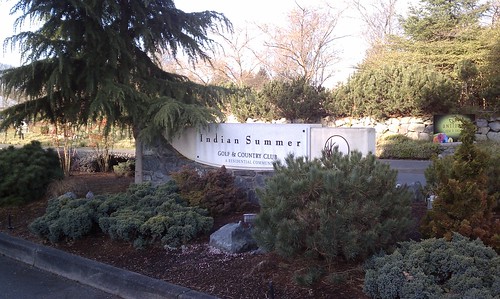We have made some pretty big advancements in our efforts to become a little more environmental friendly. The side effects of our efforts have been some real money savings. The past challenges of the economy has made everyone look at their spending. Sometimes it is easy to look over the reoccurring expenses like electricity and gas and try to reduce spending elsewhere. My General Manager Trish and I took a look at those so called "constants" and figured out a way to save.
My team has been working on a large scale compost pile to manage our waste on the course. We have expanded our efforts and are now composting all of the fresh kitchen waste as well. We are composting the waste and then planning to re-use the compost when we plant annuals in the spring and summer months. We are also building a compost tea brewer to offset or potentially replace our fairway fertilizer program through the season. The savings is not calculated fully, but the potential is a healthy savings in our waste disposal and fertilizer budget.
Our mechanic, Geoff, is looking into converting the diesel equipment into burning used vegetable oil. At $4 plus dollars per gallon this could be a huge savings in fuel costs. He has also started looking at getting a used oil heater to heat the shop rather than relying on the propane heat we currently use. The savings would be from reduction in propane usage and eliminating the cost of waste oil recycling.
Geoff has also came up with a great idea to take a portion of the money we currently spend on annual flowers for the landscape areas and invest in a greenhouse. We can then grow our own annuals each year using our compost and cheap seeds. We will have the flexibility of changing color schemes, plant variety and timing of when we can plant. This savings will large since we pay quite a bit of money on annual plantings each year.
The clubhouse lighting was our first savings improvement. We took advantage of the corporate rebate benefits from Puget Sound Energy to upgrade to LED lighting. Some of the lighting was basically free with only the cost of tax. The rebates gave us nearly a 70% discount on lighting costs.
My first challenge was to match the lumen output of the bulbs. We have over a hundred 90watt flood lights that light the banquet rooms, restaurant and lounge. They do a good job lighting the rooms and the highest output LED bulbs weren't rated quite as high in lumen output. I bought one bulb to compare in our banquet room with the same color and it turned out to look actually brighter.
Once we saw the LED lights were capable of producing the same amount of light we replaced all the bulbs that we could. Small sconce bulbs, regular lamp lights and large flood lights. It all came to a real savings of roughly $650 per month. Lights that were using 90watts went to only using 18watts. 45watt bulbs went to 3.5 watts. Even the smallest bulbs that you might pass over were close to a 90% reduction in power consumption.
I am proud to say that Indian Summer Golf and Country Club has increased the carbon credits that we currently produce. After all, the course surrounds, what is considered by the state, the highest quality wetland in Washington. We work hard to protect our beautiful surroundings with sound practices.
If you have any questions or would like to see our practices please contact me.
Justin Ruiz, CGCS, MG
Justinr@indiansummergolf.com
 I would like to ask our members a favor during the 2013 golf season. Please enter and exit the bunkers on the least sloped areas of the bunkers. This will help maintain our bunker faces and not accelerate the movement of the sand to the bottom of the bunkers. We will try to place the rakes in the best positions for entry and exit so that members will utilize these areas more often. We are also placing the rakes on the opposite sides of the green when possible so that there will not be a rake between the green and the bunker.
I would like to ask our members a favor during the 2013 golf season. Please enter and exit the bunkers on the least sloped areas of the bunkers. This will help maintain our bunker faces and not accelerate the movement of the sand to the bottom of the bunkers. We will try to place the rakes in the best positions for entry and exit so that members will utilize these areas more often. We are also placing the rakes on the opposite sides of the green when possible so that there will not be a rake between the green and the bunker. 





























